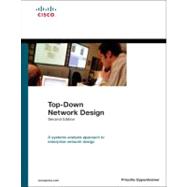
| Introduction | p. xxv |
| Identifying Your Customer's Needs and Goals | p. 3 |
| Analyzing Business Goals and Constraints | p. 5 |
| Using a Top-Down Network Design Methodology | p. 5 |
| Analyzing Business Goals | p. 10 |
| Analyzing Business Constraints | p. 21 |
| Business Goals Checklist | p. 24 |
| Summary | p. 25 |
| Analyzing Technical Goals and Tradeoffs | p. 27 |
| Scalability | p. 27 |
| Availability | p. 29 |
| Network Performance | p. 35 |
| Security | p. 49 |
| Manageability | p. 54 |
| Usability | p. 55 |
| Adaptability | p. 55 |
| Affordability | p. 56 |
| Making Network Design Tradeoffs | p. 57 |
| Technical Goals Checklist | p. 59 |
| Summary | p. 60 |
| Characterizing the Existing Internetwork | p. 63 |
| Characterizing the Network Infrastructure | p. 63 |
| Checking the Health of the Existing Internetwork | p. 76 |
| Tools for Characterizing the Existing Internetwork | p. 89 |
| Network Health Checklist | p. 92 |
| Summary | p. 93 |
| Characterizing Network Traffic | p. 95 |
| Characterizing Traffic Flow | p. 95 |
| Characterizing Traffic Load | p. 105 |
| Characterizing Traffic Behavior | p. 111 |
| Characterizing Quality of Service Requirements | p. 119 |
| Network Traffic Checklist | p. 128 |
| Summary | p. 128 |
| Summary for Part I | p. 128 |
| Logical Network Design | p. 131 |
| Designing a Network Topology | p. 133 |
| Hierarchical Network Design | p. 133 |
| Redundant Network Design Topologies | p. 145 |
| Modular Network Design | p. 148 |
| Designing a Campus Network Design Topology | p. 150 |
| Designing the Enterprise Edge Topology | p. 170 |
| Secure Network Design Topologies | p. 180 |
| Summary | p. 182 |
| Designing Models for Addressing and Naming | p. 185 |
| Guidelines for Assigning Network Layer Addresses | p. 186 |
| Using a Hierarchical Model for Assigning Addresses | p. 197 |
| Designing a Model for Naming | p. 209 |
| Summary | p. 217 |
| Selecting Switching and Routing Protocols | p. 221 |
| Making Decisions as Part of the Top-Down Network Design Process | p. 222 |
| Selecting Bridging and Switching Protocols | p. 223 |
| Selecting Routing Protocols | p. 234 |
| A Summary of IP, AppleTalk, and IPX Routing Protocols | p. 261 |
| Summary | p. 264 |
| Developing Network Security Strategies | p. 267 |
| Network Security Design | p. 267 |
| Security Mechanisms | p. 271 |
| Modularizing Security Design | p. 278 |
| Summary | p. 295 |
| Developing Network Management Strategies | p. 299 |
| Network Management Design | p. 299 |
| Network Management Processes | p. 300 |
| Network Management Architectures | p. 305 |
| Selecting Protocols for Network Management | p. 307 |
| Selecting Tools for Network Management | p. 312 |
| Summary | p. 315 |
| Summary for Part II | p. 315 |
| Physical Network Design | p. 317 |
| Selecting Technologies and Devices for Campus Networks | p. 319 |
| LAN Cabling Plant Design | p. 320 |
| LAN Technologies | p. 325 |
| Selecting Internetworking Devices for a Campus Network Design | p. 341 |
| An Example of a Campus Network Design | p. 344 |
| Summary | p. 360 |
| Selecting Technologies and Devices for Enterprise Networks | p. 363 |
| Remote-Access Technologies | p. 364 |
| Selecting Remote-Access Devices for an Enterprise Network Design | p. 374 |
| WAN Technologies | p. 377 |
| An Example of a WAN Design | p. 389 |
| Summary | p. 397 |
| Summary for Part III | p. 398 |
| Testing, Optimizing, and Documenting Your Network Design | p. 401 |
| Testing Your Network Design | p. 403 |
| Using Industry Tests | p. 404 |
| Building and Testing a Prototype Network System | p. 405 |
| Tools for Testing a Network Design | p. 412 |
| An Example of a Network Design Testing Scenario | p. 416 |
| Summary | p. 427 |
| Optimizing Your Network Design | p. 429 |
| Optimizing Bandwidth Usage with IP Multicast Technologies | p. 430 |
| Reducing Serialization Delay | p. 435 |
| Optimizing Network Performance to Meet Quality of Service Requirements | p. 437 |
| Cisco Internetwork Operating System Features for Optimizing Network Performance | p. 444 |
| Summary | p. 455 |
| Documenting Your Network Design | p. 457 |
| Responding to a Customer's Request for Proposal | p. 458 |
| Contents of a Network Design Document | p. 460 |
| Summary | p. 469 |
| Characterizing Network Traffic When Workstations Boot | p. 471 |
| References and Recommended Reading | p. 479 |
| Glossary | p. 483 |
| Index | p. 535 |
| Table of Contents provided by Ingram. All Rights Reserved. |
The New copy of this book will include any supplemental materials advertised. Please check the title of the book to determine if it should include any access cards, study guides, lab manuals, CDs, etc.
The Used, Rental and eBook copies of this book are not guaranteed to include any supplemental materials. Typically, only the book itself is included. This is true even if the title states it includes any access cards, study guides, lab manuals, CDs, etc.